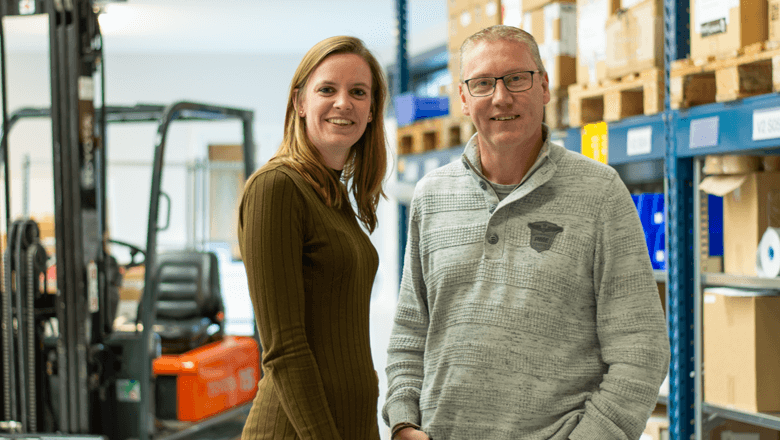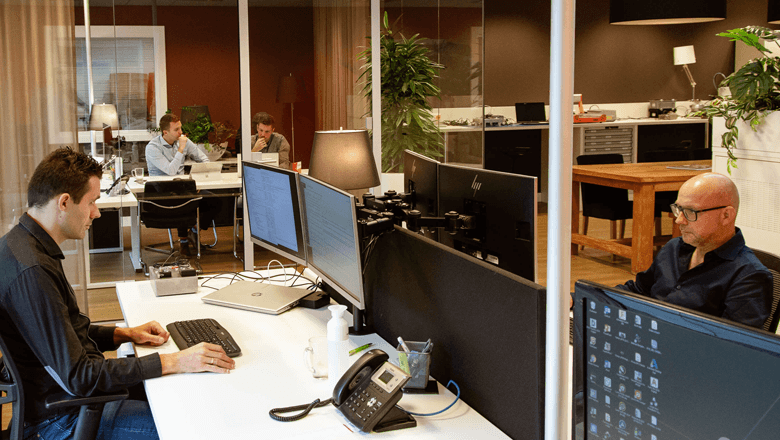Managing change at work by digitization

Changes due to digitization have an impact on your job. For example, certain tasks will disappear as a result of the introduction of smart systems. However, digitization and automation also create new opportunities for the future. If you learn how to deal with these changes, you will be able to create a future-proof job for yourself.
Changes are not only brought about by an organization’s rapid growth, but also by digitization and automation. This has a large impact on people. For example, the implementation of a new ERP package or other business software puts high demands on an organization and causes certain employee tasks to disappear.
Sentech employees learned a lot from the course of changes due to automation. They would like to share their insights with you.
Changes at work due to digitization
New systems cause changes in tasks but digitization also offers new opportunities. Not all processes can be automated, so our Project Engineers hold daily meetings in which one person of each relevant department is present.
Marco Leeggangers, Sales Director at Sentech, explains: “We hold multidisciplinary meetings to share our knowledge and keep each other informed about our processes and schedules. This type of knowledge and experience is hard to integrate into a system. Moreover, these are creative processes that cannot be automated.”
Digitization makes people indispensable
Our clients’ issues are often complex and cannot be solely solved by systems. Therefore it is important for our employees to keep developing their creative brains.
Digitization enables the automation of process progress, inspections, decisions and the entire production chain. “Still, there are many things that cannot be automated, such as unexpected situations that arise during a project. In this case it is the people who take action”, says Leeggangers.
Automation as a result of growth
In the summer of 2019, Sentech went live with Microsoft Dynamics NAV. Our old ERP system was no longer suitable due to the growth of our organization. Previously, a single person or team would be responsible for multiple tasks, but now they are spread out across multiple people and teams. This has created more separate disciplines and a higher degree of differentiation.
The new system better fits the current processes within our company. We are now handling an increasing amount of undercurrents with fewer resources.
Implementing systems in an ever-changing organization
A core team was put together for the implementation of the new ERP package. This team consisted of employees representing all departments. Every month, all Sentech employees were brought up-to-date on the project during the staff meeting. Digitization of the organization and the way of working were also discussed here.
Digitization is helpful when changes take place
Floor Verhaaf, HR Business Partner at Sentech: “In this fast-moving market, customers set different requirements. Also, the organization is growing tremendously and work processes are changing, and on top of that, a new ERP system is implemented, which is quite a lot to handle for the employees.”
At the same time, digitization can help facilitate these changes and create order in the chaos. Our aim is to have a single smooth, bottleneck-free workflow in which responsibilities are clearly defined. Now that the new software package is in place, we’re reviewing the viability of all processes.
What changes take place at work due to digitization?
As digitization further develops, employees are able to drop various tasks, leaving them more room to do work that has even more added value.
“When IT systems offer our employees better support, a purchaser, for example, will be less occupied with receipts and other administrative work. Instead, they will have more time to manage and guide suppliers”, Leeggangers emphasizes.
Internal processes are smoother
The new system holds a lot of data concerning subjects such as quality, stocks and delivery reliability. This data helps us improve internal processes and allows us to act proactively. “We get immediate insight into any bottlenecks and into the results of any changes we make to the processes”, says Verhaaf.
The more data the system holds, the more control we have. The smoother the processes, the higher the benefit for our customers. After all, the customer is what’s most important.
Making time for changes at work
Leeggangers and Verhaaf recognize the fact that Sentech employs many ambitious people who are keen to develop themselves and take on new projects. On the other hand, they are not very fond of repetitive operational activities. That’s in the DNA of our organization.
Of course, changes at work can be difficult to deal with, but they can also be fun. “Some people find it hard to deal with digitization, usually because they are afraid of losing tasks they are familiar with. We don’t see this a lot in our company, though. When a new project is started, nobody will say that they’re not up for it. At most, they will check their busy schedules to see how they can free up time for it”, Leeggangers explains.

Digitization facilitates management
Marco Leeggangers started working at Sentech as Operations Manager in 2004. In those days, the staff consisted of 5 people. Because of the strong growth of the organization, he no longer has immediate insight into what everyone is working on.
“Thanks to the available data, I have a better idea of what’s going on. It’s not that I do my job as a manager differently now. I let things run their course a little bit more. Besides, our staff knows what the management board aims for. This gives the tactical section under the management board more room for leadership. The people in the workplace know best what needs to be done. As the management board, we can now shift our focus more towards our vision and strategy”, says the Sales Director.
The future of work as a result of digitization
Digitization and automation have an impact on the future of work. Since this also affects people within our organization, Sentech felt that it needed to focus on a strategic HRM policy. Floor Verhaaf started working at Sentech as a HR Business Partner. She also joined the management team at some point. This is quite a unique step for a company of this size.
Attention to people
Attention to recruitment, selection, development and sustainable employability of people is very important, especially on this course of digitization. According to Leeggangers, the evolution towards a smart factory has a major effect on the organization and its people: “Being well-prepared for different ways of working and cooperating decreases the chance of people leaving the workforce.”
Employees will find out that they can also utilize their capabilities in a different way and sometimes even in a completely different job. “By challenging them, they grow and start to consider our future and their own future. We once again expect our turnover to increase considerably. However, as a result of digitization, this does not necessarily mean that staff numbers will also increase. Still, people remain a crucial part of our company and we highly value them”, says Leeggangers.
A look into the work week of our Engineers
Although digitization continues, not everything can be automated. Take creative processes for instance, which often come in useful during sensor integration projects.
Our Project Engineers Johan and Ivo have regular experience with this. They will tell you about their work week in high-tech. Also, with 15 ongoing projects, no day at work is the same.
What makes working in the high-tech sector so fascinating?
This article appeared in Link Magazine no 6 2019 and was written by Lucy Holl.



